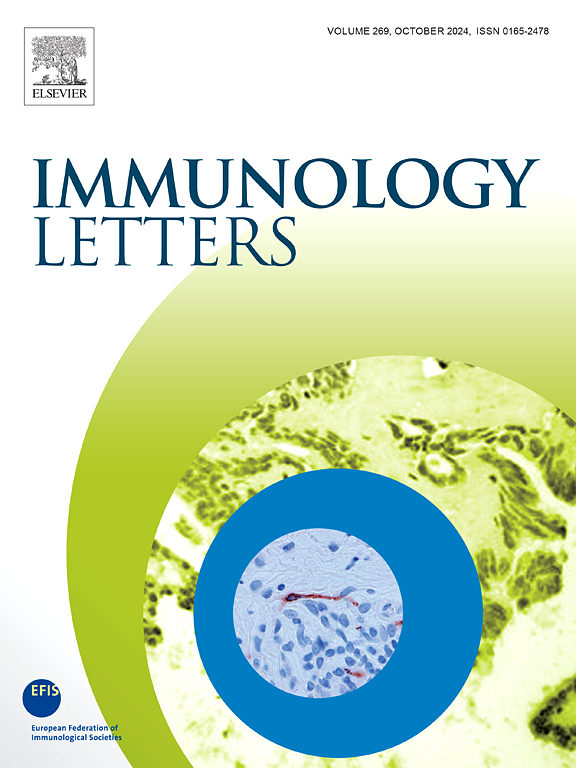METTL3/YTHDC1 mediates up-regulation of lncRNA OGRU in an m6A-dependent manner involving in oxidative stress and inflammation of HG-induced Müller cells
IF 2.8
4区 医学
Q3 IMMUNOLOGY
引用次数: 0
Abstract
Background
Diabetic retinopathy (DR) is a common complication of diabetes, which may cause visual disturbance and even loss of sight. Oxidative stress and inflammation are two crucial pathological factors of DR; however, their specific regulatory mechanisms in DR remain obscure.
Methods
DR models were established in streptozotocin-challenged rats and high glucose (HG)-stimulated Müller cells. Western blotting and RT-qPCR were performed to determine target molecule levels. ROS release was evaluated by DCFH-DA staining, and the levels of MDA, GSH, SOD, and CAT were detected using commercial kits. The levels of proinflammatory factors (TNF-α, IL-1β, IL-6, MCP-1, and CXCL-1) were analyzed by RT-qPCR and ELISA. The subcellular localization of OGRU was observed by FISH. Molecular interaction was evaluated by RIP. M6A level was assessed by MeRIP and colorimetric quantification kit.
Results
HG stimulation or diabetic stress resulted in an elevation in the overall m6A level, as well as expression level of methyltransferase-like 3 (METTL3) in the experimental models of DR. M6A writer METTL3 stabilized lncRNA OGRU via m6A modification. Functionally, METTL3 deficiency relieved HG-induced oxidative stress damage and inflammation in Müller cells. Rescue assays demonstrated that OGRU overexpression reversed METTL3 silencing-mediated protection against HG-stimulated Müller cells. Furthermore, YTH Domain-Containing Protein 1 (YTHDC1) coordinated with METTL3 to enhance OGRU stability in an m6A-dependent manner.
Conclusion
METTL3-mediated m6A modification stabilized OGRU with assistance of YTHDC1, which led to oxidative stress and inflammation during DR progression. Targeting METTL3/YTHDC1/OGRU axis might be a potential therapeutic strategy for DR.

METTL3/YTHDC1以m6A依赖方式介导lncRNA OGRU的上调,参与HG诱导的Müller细胞的氧化应激和炎症。
背景:糖尿病视网膜病变(DR)是糖尿病的常见并发症,可导致视力障碍甚至失明。氧化应激和炎症是DR的两个重要病理因素;然而,它们在DR中的具体调控机制仍不清楚。方法:采用链脲佐菌素刺激大鼠和高糖刺激大鼠 ller细胞建立DR模型。Western blotting和RT-qPCR检测靶分子水平。DCFH-DA染色评估ROS释放,使用商用试剂盒检测MDA、GSH、SOD和CAT水平。采用RT-qPCR和ELISA检测促炎因子(TNF-α、IL-1β、IL-6、MCP-1、CXCL-1)水平。FISH观察OGRU的亚细胞定位。用RIP评价分子相互作用。采用MeRIP和比色定量试剂盒检测M6A水平。结果:HG刺激或糖尿病应激导致DR. m6A实验模型中m6A总体水平升高,甲基转移酶样3 (methyltransferase-like 3, METTL3)表达水平升高。功能上,METTL3缺乏可减轻hg诱导的心肌细胞氧化应激损伤和炎症。援救实验表明,OGRU过表达逆转了METTL3沉默介导的对hg刺激的 ller细胞的保护作用。此外,YTH Domain-Containing Protein 1 (YTHDC1)与METTL3协同,以m6a依赖的方式增强OGRU的稳定性。结论:mettl3介导的m6A修饰在YTHDC1的帮助下稳定了OGRU,导致DR进展过程中的氧化应激和炎症。靶向METTL3/YTHDC1/OGRU轴可能是治疗DR的潜在策略。
本文章由计算机程序翻译,如有差异,请以英文原文为准。
求助全文
约1分钟内获得全文
求助全文
来源期刊

Immunology letters
医学-免疫学
CiteScore
7.60
自引率
0.00%
发文量
86
审稿时长
44 days
期刊介绍:
Immunology Letters provides a vehicle for the speedy publication of experimental papers, (mini)Reviews and Letters to the Editor addressing all aspects of molecular and cellular immunology. The essential criteria for publication will be clarity, experimental soundness and novelty. Results contradictory to current accepted thinking or ideas divergent from actual dogmas will be considered for publication provided that they are based on solid experimental findings.
Preference will be given to papers of immediate importance to other investigators, either by their experimental data, new ideas or new methodology. Scientific correspondence to the Editor-in-Chief related to the published papers may also be accepted provided that they are short and scientifically relevant to the papers mentioned, in order to provide a continuing forum for discussion.
文献相关原料
公司名称
产品信息
索莱宝
GPx
索莱宝
SOD
索莱宝
MDA
索莱宝
GSH
 求助内容:
求助内容: 应助结果提醒方式:
应助结果提醒方式:


